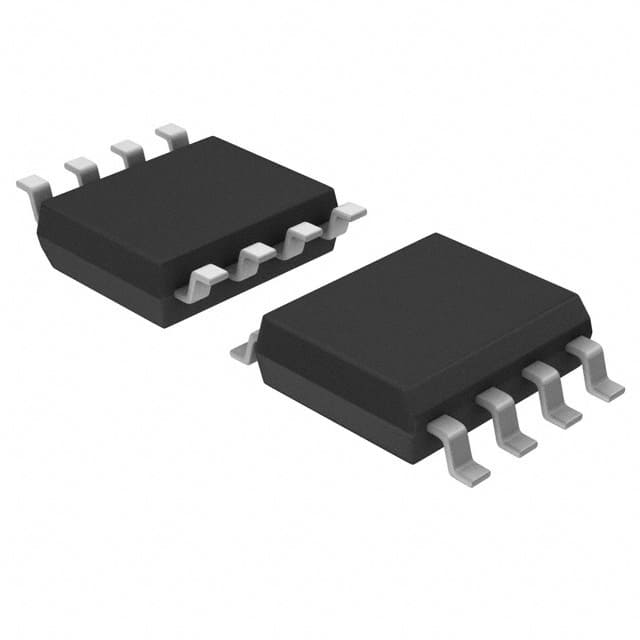ATTINY102-MFR
Product Overview
Category
The ATTINY102-MFR belongs to the category of microcontrollers.
Use
This microcontroller is commonly used for various electronic applications that require low-power and high-performance capabilities.
Characteristics
- Low power consumption
- High performance
- Compact size
- Versatile functionality
Package
The ATTINY102-MFR is available in a compact package, making it suitable for space-constrained designs.
Essence
The essence of the ATTINY102-MFR lies in its ability to provide efficient and reliable control for electronic devices while consuming minimal power.
Packaging/Quantity
This microcontroller is typically packaged individually or in reels, depending on the quantity required by the user.
Specifications
- Architecture: AVR
- Flash Memory: 1KB
- RAM: 32 bytes
- Operating Voltage: 1.8V - 5.5V
- Digital I/O Pins: 6
- Analog Input Pins: 4
- PWM Channels: 2
- Communication Interfaces: SPI, I2C, UART
- Clock Speed: Up to 20MHz
Detailed Pin Configuration
The ATTINY102-MFR features a total of 8 pins, each serving a specific purpose:
- VCC: Power supply voltage input
- GND: Ground reference
- RESET: Reset pin for restarting the microcontroller
- PB3: General-purpose digital I/O pin
- PB4: General-purpose digital I/O pin
- PB0: General-purpose digital I/O pin
- PB1: General-purpose digital I/O pin
- PB2: General-purpose digital I/O pin
Functional Features
- Low-power sleep modes for energy efficiency
- Built-in EEPROM memory for data storage
- Timers and counters for precise timing operations
- Analog-to-Digital Converter (ADC) for analog signal processing
- Interrupt capability for event-driven programming
Advantages and Disadvantages
Advantages
- Low power consumption extends battery life in portable devices
- Compact size allows for integration into small form factor designs
- Versatile functionality enables a wide range of applications
- Cost-effective solution for microcontroller-based projects
Disadvantages
- Limited flash memory capacity may restrict the complexity of programs
- Limited RAM size may impose constraints on data storage and manipulation
Working Principles
The ATTINY102-MFR operates based on the AVR architecture, utilizing a combination of hardware and software to execute programmed instructions. It follows a sequential execution model, where instructions are fetched from memory, decoded, and executed by the microcontroller.
Detailed Application Field Plans
The ATTINY102-MFR finds applications in various fields, including but not limited to:
- Internet of Things (IoT) devices
- Home automation systems
- Wearable technology
- Sensor networks
- Embedded systems
- Consumer electronics
Detailed and Complete Alternative Models
- ATTINY104-MFR: Similar to ATTINY102-MFR with extended flash memory capacity.
- ATTINY85-MFR: A smaller variant with reduced I/O pins and memory capacity.
- ATTINY2313-MFR: Offers enhanced features and higher performance compared to ATTINY102-MFR.
These alternative models provide options with varying capabilities to suit different project requirements.
Word count: 408 words
רשום 10 שאלות ותשובות נפוצות הקשורות ליישום של ATTINY102-MFR בפתרונות טכניים
Sure! Here are 10 common questions and answers related to the application of ATTINY102-MFR in technical solutions:
Q: What is ATTINY102-MFR? A: ATTINY102-MFR is a microcontroller from Microchip Technology, specifically designed for low-power applications.
Q: What are the key features of ATTINY102-MFR? A: Some key features of ATTINY102-MFR include 1KB Flash memory, 32B SRAM, 6 general-purpose I/O pins, and a 8-bit AVR microcontroller core.
Q: What are some typical applications of ATTINY102-MFR? A: ATTINY102-MFR is commonly used in applications such as battery-powered devices, sensors, IoT devices, and small embedded systems.
Q: How can I program ATTINY102-MFR? A: ATTINY102-MFR can be programmed using various programming tools, such as Atmel Studio, Arduino IDE, or other compatible development environments.
Q: What is the power consumption of ATTINY102-MFR? A: ATTINY102-MFR is known for its low power consumption, with an active mode current of around 300µA at 1MHz and 1.8V.
Q: Can ATTINY102-MFR communicate with other devices? A: Yes, ATTINY102-MFR supports serial communication protocols like SPI and I2C, allowing it to communicate with other devices such as sensors or displays.
Q: Does ATTINY102-MFR have built-in analog-to-digital converters (ADC)? A: No, ATTINY102-MFR does not have built-in ADCs. However, external ADCs can be used if analog measurements are required.
Q: What is the maximum clock frequency of ATTINY102-MFR? A: The maximum clock frequency of ATTINY102-MFR is 20MHz, allowing for faster execution of instructions.
Q: Can I use ATTINY102-MFR in industrial environments? A: Yes, ATTINY102-MFR is suitable for industrial environments as it can operate within a wide temperature range (-40°C to +105°C).
Q: Is ATTINY102-MFR a cost-effective solution? A: Yes, ATTINY102-MFR is a cost-effective microcontroller, making it an ideal choice for low-cost and power-constrained applications.
Please note that these answers are general and may vary depending on specific requirements and use cases.


